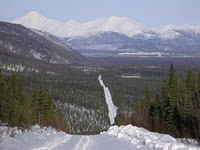Fun Facts About Wind Cave National Park
 Wind Cave National Park is located in the Black Hills of South Dakota.
Wind Cave National Park is located in the Black Hills of South Dakota.
Tom and Jesse Bingham are credited with the discovery of Wind Cave in 1881.
Exploration has revealed 87 miles of passageways to date, which makes Wind Cave the fifth largest cave system in the United States, and eighth in the world.
The Cave gets its name from the wind that blows through, which during March-August of 1985 was measured to be >75 mph (120 kph) is highest recorded measurement at Walk-In Entrance before revolving door was installed. The highest recorded measurement at the Natural Entance was 25 mph (40 kph). North Room 0.28-1.75 mph (.5-2.8 kph).
An average of 1,000,000 ft³ (28317 m³) of air from the cave is exchanged with the surface each hour.
The Park features the most boxwork of any known cave and the most complex 3D rectilinear maze cave (network maze).
The Park also features one of the most diverse mineralogical and speleothem assemblages and one of the largest barometric wind caves in the United States.
Other natural features of the Cave are helictite bushes, quartz rinds, logomites, hydromagnesite ballons, dogtooth and nailhead spar, quartz, christmas trees, button popcorn, sawtooth flowstone, gypsum luster, flowers, starbursts, and hair conulites.
Wind Cave is over 300 million years old, making it one of the oldest in the world. Besides extreme age, other features make Wind Cave unique. The cave is large and extremely complex, the 81 miles of known cave (1998) fit under one square mile of land. The boxwork is rare and found in few other caves. Wind Cave has undergone many geological changes and the processes continue.
The Cave’s boundaries are within a 1.1 by 1.3 mile rectangle (370.4 ha) on the surface.
The park was heavily exploited during it’s early days. Many features were removed, names carved on walls, and a lot of trash and outside debris was brought in.
On Jan 3, 1903, President Theodore Roosevelt signed the bill creating Wind Cave National Park. It was the seventh national park and the first one created to protect a cave. The parklands at that time were small and there were no bison, elk, or pronghorn. They came later as the park boundaries expanded.
In 1912, the American Bison Society was looking for a place to reestablish a bison herd. Because of the excellent prairie habitat around the park, a national game preserve was established bordering Wind Cave. It was managed by the U.S. Biological Survey. In 1913 and 1914, the animals began to arrive. Fourteen bison came from the New York Zoological Society, twenty-one elk arrived from Wyoming and thirteen pronghorn came from Alberta, Canada.
In July of 1935, the game preserve became part of Wind Cave National Park. During the early years of the preserve, the animals were kept in small enclosures. Eventually, it was realized that they needed more space. The bison and elk needed additional forage and the pronghorn needed room to escape from predators. With the help of the Civilian Conservation Corps (CCC), fences within the park were removed. And in 1946, 16,341 additional acres were added, enlarging the park to 28,059 acres.
Serious exploration of the caves did not begin until 1956, and during 1963 to 1965 major additions to the known territory of Wind Cave were made.
In the 1970’s and 80’s, managers continued to focus on caring for the wildlife and rangeland by building an understanding of how the natural systems should function. The reintroduction of fire as a natural means to improve the range and to limit the expansion of the forest onto the prairie was researched. An active fire program was started, with the first prescribed fire occurring in 1972.
Exploration is still on going today (and the ranks of which cave is largest changes frequently).
Wind Cave National Park is open year round with visitation the highest in June, July and August and lowest in December, January and February.
The length of the surveyed cave is 135 miles (217.26 kilometers).
The deepest point surveyed are the underground lakes, which are 654 feet (199.3 m) below the highest point in the cave.
Not only does Wind Cave National Park protect the 87 miles of passageways below it, but is home to a host of Black Hills features including mountains, ponderosa forest, prairies, and the most miles of established, maintained, hiking trails of all of the National Park facilities located in South Dakota.
Wind Cave National Park by default is also an excellent jumping off point to see other Black Hills attractions like Custer State Park, Mt. Rushmore National Memorial, Jewel Cave National Monument, and the Crazy Horse Memorial.
Calcite Rafts, a thin layer of calcite stone, floats on the top of the lakes. The unusual stone formation will sink when the surface tension of the water is broken. These formations have been found in dry parts of the cave, adding to the evidence that the water levels in the Black Hills have rose and receded over the millennium, creating the numerous caves we can see today.
Wind Cave National Park also offers a wider variety of tours and programs for visitors than it’s smaller sibling to the west, Jewel Cave National Monument.
Special thanks to wind.cave.national-park.com, outdoorplaces.com and nps.gov



































































 The Mind of Adam J. Kovitz
The Mind of Adam J. Kovitz